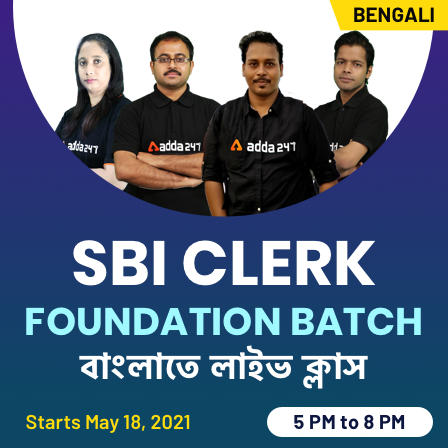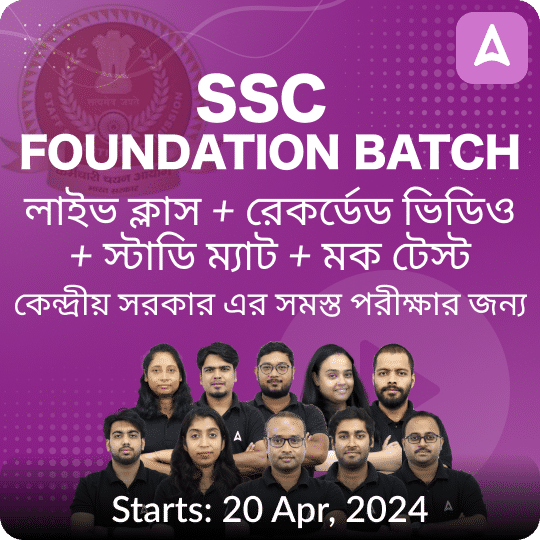Q1. নিম্নলিখিত এই আইন গুলি পাশের ক্রমানুসারে সাজান
- হিন্দু বিবাহ আইন
- মাতৃত্ব বেনিফিট আইন
- সারদা আইন
- হিন্দু বিধবাদের পুনঃবিবাহ আইন,
নীচে থেকে সঠিক কোডটি নির্বাচন করুন:
(a) 3-4-2-1
(b) 4-3-2-1
(c) 3-4-1-2
(d) 4-3-1-2
Q2. রাধাস্বামী আন্দোলন সম্পর্কিত নিম্নলিখিত বিবৃতি বিবেচনা করুন
- রাধাস্বামীরা একের পরম সত্তা, গুরুর আধিপত্য, ধার্মিক ব্যক্তিদের একটি দল এবং একটি সাধারণ সামাজিক জীবনে বিশ্বাসী
- তারা সমস্ত ধর্মকে সত্য বলে বিবেচনা করে এবং এই সম্প্রদায়ের মন্দিরে কোনও বিশ্বাস নেই
উপরোক্ত বিবৃতিগুলির মধ্যে কোনটি সঠিক / কোনগুলি সঠিক?
(a) কেবল 1
(b) কেবল 2
(c) 1 এবং 2 উভয়ই
(d) 1 বা 2 কোনোটিই নয়
Q3. নিম্নলিখিত কার দ্বারা ইন্ডিয়ান লীগ শুরু হয়েছিল –
(a) দাদাভাই নওরোজি
(b) শিশির কুমার ঘোষ
(c) গোপাল কৃষ্ণ গোখলে
(d) সুভাষ চন্দ্র বসু
Q4. ইন্ডিয়ান অ্যাসোসিয়েশন অফ কলকাতা বা আইএনএ সম্পর্কিত নিম্নলিখিত বিবৃতি বিবেচনা করুন
- এটি ভারতীয় সিভিল সার্ভিস পরীক্ষার প্রার্থীদের বয়সসীমা হ্রাস করার বিরুদ্ধে প্রতিবাদ করেছিল
- এটি অসহযোগ আন্দোলনের পুনরুদ্ধারের পরিপ্রেক্ষিতে ভারতীয় জাতীয় কংগ্রেসের অসন্তুষ্ট নেতাদের দ্বারা গঠিত হয়েছিল
উপরোক্ত বিবৃতিগুলির মধ্যে কোনটি সঠিক / কোনগুলি সঠিক?
(a) কেবল 1
(b) কেবল 2
(c) 1 এবং 2 উভয়ই
(d) 1 বা 2 কোনোটিই নয়
Q5. নীচের কোনটি চোল রাজ্যের খুব বিখ্যাত বন্দর ছিল?
(a) পোম্পুহার
(b) নেলুরু
(c) মসলিপট্টনাম
(d) কাকিনাদা
Q6. নিম্নলিখিতগুলির মধ্যে কে ছিলেন কলকাতা বিশ্ববিদ্যালয়ের প্রথম মহিলা স্নাতক, যিনি কংগ্রেস অধিবেশনকে সম্বোধন করেছিলেন, যা ভারতের নারীদের জাতীয় জীবনে তাদের যথাযথ মর্যাদা দেওয়ার স্বাধীনতা সংগ্রামের প্রতিশ্রুতির প্রতীক।
(a) সরোজিনী নাইডু
(b) ঊষা মেহতা
(c) কাদম্বিনী গাঙ্গুলি
(d) অ্যানি বেসান্ত
Q7. ভারতীয় কাউন্সিল আইন 1892 সম্পর্কিত নিম্নলিখিত বিবৃতি বিবেচনা করুন
- বাজেট নিয়ে আলোচনা হতে পারে।
- বাজেটে ভোট দেওয়া যায় এবং সংশোধনী প্রস্তাব করা যেতে পারে
- বিশ্ববিদ্যালয়, পৌরসভা, জমিদারদের প্রতিনিধিত্বের অনুমতি ছিল
উপরোক্ত বিবৃতিগুলির মধ্যে কোনটি সঠিক /কোনগুলি সঠিক?
(a) 1 এবং 2
(b) 2 এবং 3
(c) 1 এবং 3
(d) কেবল 2
Q8. বঙ্গভঙ্গ সম্পর্কে স্বদেশী আন্দোলনের প্রতিক্রিয়াতে গণ-অংশগ্রহণ নিয়ে নিম্নলিখিত বিবৃতি বিবেচনা করুন
- সমগ্র মুসলিম সম্প্রদায় আন্দোলনে অংশ নেয়নি এবং পুরো উৎসাহে বঙ্গভঙ্গকে সমর্থন করেছিল
- আন্দোলনের সামাজিক ভিত্তি জমিদারি, ছাত্র, মহিলা এবং শহর ও শহরে নিম্ন মধ্যবিত্তের কিছু অংশকে প্রসারিত করেছিল
উপরোক্ত বিবৃতিগুলির মধ্যে কোনটি সঠিক / কোনগুলি সঠিক?
(a) কেবল 1
(b) কেবল 2
(c) 1 এবং 2 উভয়ই
(d) 1 বা 2 কোনোটিই নয়
Q9. রথ মন্দিরগুলি শিলা কাটা গুহা মন্দির এবং ফ্রিস্ট্যান্ডিং পাথর মন্দিরের মধ্যে স্থানান্তর স্থান হিসাবে বিবেচিত হয়। রথ মন্দিরগুলি- এর রাজত্বকালে নির্মিত হয়েছিল
(a) চেরা
(b) চালুক্য
(c) পান্ড্য
(d) পল্লব
Q10. 1909-এর ভারতীয় কাউন্সিল আইন সম্পর্কিত নিম্নলিখিত বিবৃতি বিবেচনা করুন।
- প্রথমবারের মতো কেন্দ্রীয় কাউন্সিলে নির্বাচনের জন্য মুসলমানদের জন্য পৃথক ভোটার নির্বাচিত হয়েছিল
- প্রথমবারের জন্য নির্বাচিত সদস্যগণ সরাসরি নির্বাচিত হতেন
- একজন ভারতীয়কে ভাইসরয়ের কার্যনির্বাহী পরিষদে নিয়োগ দেওয়া হয়েছিল
উপরোক্ত বিবৃতিগুলির মধ্যে কোনটি সঠিক / কোনগুলি সঠিক?
(a) 1 এবং 2
(b) 2 এবং 3
(c) 1 এবং 3
(d) কেবল 2
Solutions
S1.Ans.(d)
Sol.
Legislative Measures for Women Bengal Regulation (1829) banning sati Bengal Regulations (1795, 1804)—declaring infanticide illegal. Hindu Widows’ Remarriage Act, 1856. Age of Consent Act, 1891 Sarda Act, 1930 Special Marriage Act, 1954 Hindu Marriage Act, 1955 Hindu Succession Act, 1956 Hindu Adoption and Maintenance Act Maternity Benefits Act, 1961 Equal Remuneration Act, 1976 Child Marriage Restraint (Amendment) Act, 1978 Suppression of Immoral Traffic Act in Women and Girls, 1956 (amended in 1986) Dowry Prohibition Act, 1961 (amended in 1986)
S2.Ans.(c)
Sol.
Radhaswami Movement Tulsi Ram, a banker from Agra, also known as Shiv Dayal Saheb, founded this movement in 1861. The Radhaswamis believe in one supreme being, the supremacy of the guru, a company of pious people (Satsang), and simple social life. Spiritual attainment, they believe, does not call for renunciation of the worldly life. They consider all religions to be true. While the sect has no belief in temples, shrines, and sacred places, it considers as necessary duties, works of faith and charity, service, and prayer
S3.Ans.(b)
Sol.
The Indian League was started in 1875 by Sisir Kumar Ghosh with the object of “stimulating the sense of nationalism amongst the people” and of encouraging political education.
S4.Ans.(a)
Sol.
The Indian Association of Calcutta (also known as the Indian National Association) superseded the Indian League and was founded in 1876 by younger nationalists of Bengal led by Surendranath Banerjea and Ananda Mohan Bose, who were getting discontented with the conservative and pro-landlord policies of the British Indian Association.
t protested against the reduction of the age limit in 1877 for candidates of the Indian Civil Service examination. The association demanded simultaneous holding of civil service examination in England and India and Indianisation of higher administrative posts. It led to a campaign against the repressive arms act and the vernacular press act
The association sponsored an all-India conference which first took place in Calcutta on December 28 to 30, 1883. More than a hundred delegates from different parts of the country attended. So, in a way, the association was a forerunner of the Indian National Congress as an all-India nationalist organization. It later merged with the Indian National Congress in 1886.
S5.Ans.(a)
Sol.
The Chola Dynasty port city in Tamil Nadu that vanished from maritime history around 1,000 years ago will be digitally reconstructed by a consortium led by the Department of Science and Technology. The reconstruction of Poompuhar is part of DST’s Indian Digital Heritage project — an exhibition of its first project ‘Digital Hampi’ is currently on display at the National Museum here.
S6.Ans.(c)
Sol.
In 1890, Kadambini Ganguly, the first woman graduate of Calcutta University, addressed the Congress session, which symbolized the commitment of the freedom struggle to give the women of India their due status in national life
S7.Ans.(a)
Sol.
Indian Councils Act 1892 Main Provisions
- Number of additional members in Imperial Legislative Councils and the Provincial Legislative Councils was raised. In Imperial Legislative Council, now the governor-general could have ten to sixteen non-officials (instead of six to ten previously).
- The non-official members of the Indian legislative council were to be nominated by the Bengal Chamber of Commerce and provincial legislative councils. The members could be recommended by universities, municipalities, zamindars, and chambers of commerce. So the principle of representation was introduced.
- The budget could be discussed.
- Questions could be asked.
Limitations
- The officials retained their majority in the council, thus making ineffective the non-official voice.
- The ‘reformed’ Imperial Legislative Council met, during its tenure till 1909, on an average for only thirteen days in a year, and the number of unofficial Indian members present was only five out of twenty-four.
- The budget could not be voted upon, nor could any amendments be made to it.
- Supplementaries could not be asked, nor could answers to any question be discussed.
S8.Ans.(b)
Sol.
Stand of Muslims
Some of the Muslims participated— Barrister Abdul Rasul, Liaqat Hussain, Guznavi, Maulana Azad (who joined one of the revolutionary terrorist groups); but most of the upper and middle-class Muslims stayed away or, led by Nawab Salimullah of Dacca, supported the partition on the plea that it would give them a Muslim-majority East Bengal. To further government interests, the All India Muslim League was propped up on December 30, 1905, as an anti congress front, and reactionary elements like Nawab Salimullah of Dacca were encouraged. Statement (1) is incorrect
the social base of the movement expanded to include certain sections of the zamindari, the students, the women, and the lower middle classes in cities and towns. An attempt was also made to give political expression to the economic grievances of the working class by organizing strikes. But the movement was not able to garner the support of the Muslims, especially the Muslim peasantry, because of a conscious government policy of divide and rule helped by the overlap of class and community at places.
S9.Ans.(d)
Sol.
Ratha temples were cut during the reign of Pallava King Narasimhavarman I( 630–680 AD; also called Mamalla , or “great warrior”).
The ‘ Ratha ‘ cave temples are usually called the ” Panch Pandava Ratha ” (the five chariots of the Pandavas ). The Ratha temples are regarded as the transition point between the rock-cut cave temples and freestanding stone temples. The temples at Mahabalipuram are called Ratha temples as they resemble the shape of rathas (chariots). These temples are known especially for their Rathas and ”
Mandapas ” (an open pavilion or a hall).
S10.Ans.(c)
Sol.
As per the 1909 act:
One Indian was to be appointed to the viceroy’s executive council (Satyendra Sinha was the first Indian to be appointed in 1909)
The elected members were to be indirectly elected. The local bodies were to elect an electoral college, which in turn would elect members of provincial legislatures, who in turn would elect members of the central legislature
For the first time, separate electorates for Muslims for election to the central council were established—a most detrimental step for India.









